
The Spider is an American pulp-magazine hero of the 1930s and 1940s. The character was created by publisher Harry Steeger and written by a variety of authors for 118 monthly issues of The Spider from 1933 to 1943. The Spider sold well during the 1930s, and copies are valued by modern pulp magazine collectors. Pulp magazine historian Ed Hulse has stated "Today, hero-pulp fans value The Spider more than any single-character magazine except for The Shadow and Doc Savage."

John Warren Hull, known professionally as Warren Hull, was an American actor, singer and television personality active from the 1930s through the 1960s. He was one of the most popular serial actors in the action-adventure field.

James Wesley Horne was an American actor, screenwriter, and film director.

Zombies of the Stratosphere is a 1952 black and white Republic Studios serial directed by Fred C. Brannon, with a screenplay by Ronald Davidson, and special effects by Republic's Lydecker brothers. It was intended to be Republic's second serial featuring "new hero" Commando Cody and the third 12-chapter serial featuring the rocket-powered flying jacket and helmet introduced in King of the Rocket Men (1949). Instead, for reasons unknown, the hero was renamed "Larry Martin", who must prevent Martian invaders from using a hydrogen bomb to blow Earth out of its orbit, so that the Martians can move a dying Mars into a much closer orbital position to the Sun. As in Radar Men from the Moon, much of the screen time for each of the dozen chapters is spent on fistfights and car chases between the heroes and a gang of earthly crooks hired by renegade scientist Dr. Harding and his extraterrestrial colleague Marex to steal and stockpile the Atomic supplies needed for construction of the H-bomb.
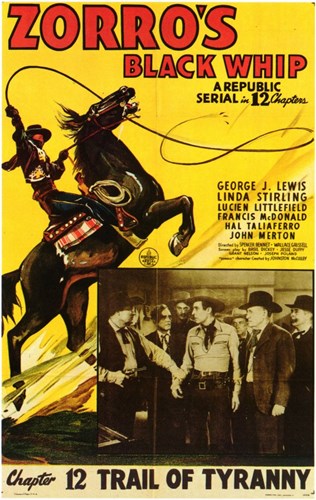
Zorro's Black Whip is a 1944 12-chapter film serial by Republic Pictures starring Linda Stirling. The film was made after the 1940 20th Century-Fox remake of The Mark of Zorro in order to capitalize on it. Republic was not able to use the character of Zorro himself, however, and despite the title, the hero(ine) is called The Black Whip throughout.

Superman is a 1948 15-part Columbia Pictures film serial based on the comic book character Superman. It stars an uncredited Kirk Alyn and Noel Neill as Lois Lane. Like Batman (1943), it is notable as the first live-action appearance of Superman on film, and for the longevity of its distribution. The serial was directed by Thomas Carr, who later directed many early episodes of the Adventures of Superman television series, and Spencer Gordon Bennet, produced by Sam Katzman, and shot in and around Los Angeles, California. It was originally screened at movie matinées, and after the first three scene-setting chapters, every episode ends in a cliffhanger. The Superman-in-flight scenes are animations, in part due to the small production budget.
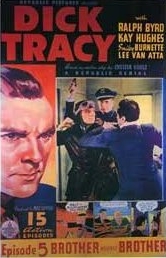
Dick Tracy (1937) is a 15-chapter Republic movie serial starring Ralph Byrd based on the Dick Tracy comic strip by Chester Gould. It was directed by Alan James and Ray Taylor.

A masked villain, also seen as masked mystery villain, is a stock character in genre fiction. It was developed and popularized in movie serials, beginning with The Hooded Terror in The House of Hate, (1918) the first fully-costumed mystery villain of the movies, and frequently used in the adventure stories of pulp magazines and sound-era movie serials in the early twentieth century, as well as postmodern horror films where the character "hides in order to claim unsuspecting victims". They can also appear in crime fiction to add to the atmosphere of suspense and suspicion. It is used to engage the readers or viewers by keeping them guessing just as the characters are, and suspension by drawing on the fear of the unknown. The "Mask" need not be literal, referring more to the subterfuge involved.
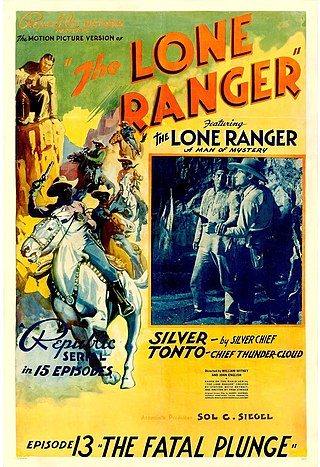
The Lone Ranger is a 1938 American Republic Pictures movie serial based on The Lone Ranger radio program. It was the ninth of the sixty-six serials produced by Republic, the fourth Western and the first Republic serial release of 1938. The following year a sequel serial The Lone Ranger Rides Again was released. The fifteen chapters of the serial were condensed into the film Hi-Yo Silver, which was released in 1940.

Batman is a 1943 American 15-chapter theatrical serial from Columbia Pictures, produced by Rudolph C. Flothow, directed by Lambert Hillyer, that stars Lewis Wilson as Batman and Douglas Croft as his sidekick Robin. The serial is based on the DC Comics character Batman, who first appeared in Detective Comics #27 in May 1939. The villain is an original character named Dr. Daka, a secret agent of the Japanese Imperial government, played by J. Carrol Naish. Rounding out the cast are Shirley Patterson as Linda Page, Bruce Wayne's love interest, and William Austin as Alfred, the Wayne Manor butler.

The Scarlet Horseman is a 1946 American Western film serial from Universal Pictures. It is directed by Lewis D. Collins and Ray Taylor. Paul Guilfoyle plays Jim Bannion, secret identity of The Scarlet Horseman, with Janet Shaw as Elise, his love interest. Virginia Christine plays the villainess, Matosca.
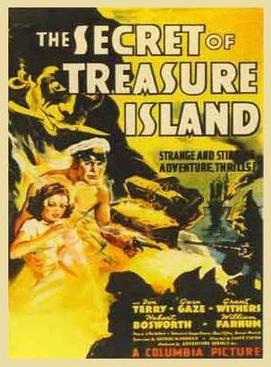
The Secret of Treasure Island is a 1938 Columbia movie serial based on the serialized Argosy magazine story Murder at Pirate Castle (1936). The magazine story was written by L. Ron Hubbard, at the time a writer of pulp fiction who went on to found the Scientology religion.

The Spider's Web is a 1938 Columbia Pictures movie serial based on the popular pulp magazine character The Spider. It was the fifth of the 57 serials released by Columbia.

The Shadow (1940) was the ninth serial released by Columbia Pictures. It was based upon the classic radio series and pulp magazine superhero character of the same name.
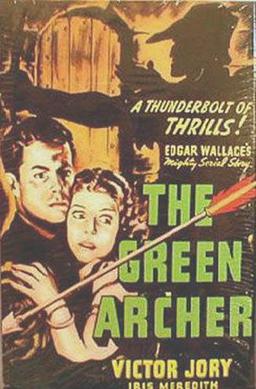
The Green Archer is the 12th serial released by Columbia Pictures. It was based on Edgar Wallace's 1923 novel The Green Archer, which had previously been adapted into the silent serial of the same name in 1925 by Pathé Exchange.
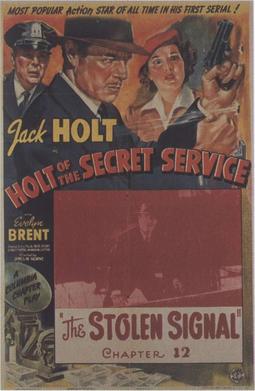
Holt of the Secret Service (1941) was the 16th serial released by Columbia Pictures.

Captain Midnight is a 1942 American serial film. It was Columbia Pictures 17th released serial and was based upon the radio adventure serial of the same name, broadcast from 1938 to 1949. Captain Midnight was only one of the many aviation serials released during World War II, whose leading characters were derived from early pulp magazines and radio show favorites.
Raymond Edgar Taylor was an American film director. He directed 159 films between 1926 and 1949. His debut was the 1926 film serial Fighting with Buffalo Bill.

A serial film,film serial, movie serial, or chapter play, is a motion picture form popular during the first half of the 20th century, consisting of a series of short subjects exhibited in consecutive order at one theater, generally advancing weekly, until the series is completed. Usually, each serial involves a single set of characters, protagonistic and antagonistic, involved in a single story, which has been edited into chapters after the fashion of serial fiction and the episodes cannot be shown out of order or as a single or a random collection of short subjects.

The Spider was an American pulp magazine published by Popular Publications from 1933 to 1943. Every issue included a lead novel featuring the Spider, a heroic crime-fighter. The magazine was intended as a rival to Street & Smith's The Shadow and Standard Magazine's The Phantom Detective, which also featured crime-fighting heroes. The novels in the first two issues were written by R. T. M. Scott; thereafter every lead novel was credited to "Grant Stockbridge", a house name. Norvell Page, a prolific pulp author, wrote most of these; almost all the rest were written by Emile Tepperman and A. H. Bittner. The novel in the final issue was written by Prentice Winchell.




















